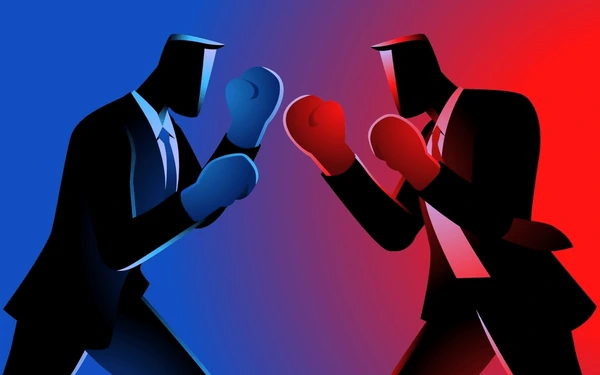Hello, aspiring scholars and future business leaders! In your academic journey, you’ll encounter numerous concepts that play a critical role in understanding how the business world operates.
One of the key dynamics you’ll study is competitive rivalry—how companies battle it out in the marketplace to capture customers, grow their market share, and stay ahead of the competition. These rivalries aren’t just dry business jargon; they’re the real-world stories of innovation, strategy, and sometimes, fierce competition that have shaped the industries we know today.
In this post, we’ll explore some iconic examples of competitive rivalry, breaking down how these battles have driven companies to push the envelope and transform their industries.
Understanding these concepts will not only help you in your studies but also give you a deeper appreciation of the strategic thinking that defines successful businesses.
1. Coca-Cola vs. Pepsi
- Industry: Soft Drinks
- Historical Context: The rivalry between Coca-Cola and Pepsi dates back over a century, with both companies vying for dominance in the carbonated soft drink market. The “Cola Wars” intensified in the 1970s and 1980s when both companies engaged in aggressive advertising and marketing campaigns to win over consumers.
- Key Strategies:
- Product Differentiation: Coca-Cola has traditionally focused on its classic formula and brand heritage, while Pepsi has positioned itself as the choice for younger generations with campaigns like the “Pepsi Generation.”
- Marketing and Advertising: Both companies have used celebrity endorsements, Super Bowl commercials, and global marketing campaigns to build brand loyalty. For example, Pepsi’s famous “Pepsi Challenge” in the 1980s encouraged blind taste tests against Coca-Cola, directly challenging Coke’s market leadership.
- Global Expansion: Both Coca-Cola and Pepsi have aggressively expanded into international markets, tailoring their products and marketing strategies to local tastes. This has included the introduction of new flavors, sugar-free variants, and region-specific products.
- Impact on the Industry: The rivalry has led to significant innovation in product development, packaging, and distribution. It has also driven competitive pricing strategies, promotional discounts, and seasonal product launches (e.g., holiday-themed packaging). The intense competition has forced both companies to continually adapt to changing consumer preferences, such as the shift toward healthier beverages.
2. Apple vs. Samsung
- Industry: Smartphones and Consumer Electronics
- Historical Context: Apple and Samsung’s rivalry became particularly pronounced in the late 2000s with the rise of smartphones. Apple’s iPhone, launched in 2007, set new standards for design and functionality, which Samsung quickly sought to challenge with its Galaxy series.
- Key Strategies:
- Innovation: Both companies invest heavily in research and development to bring new features to market, such as improved cameras, enhanced security (like Face ID vs. fingerprint sensors), and high-resolution displays (e.g., Retina Display vs. AMOLED).
- Legal Battles: The rivalry has also played out in the courtroom, with Apple and Samsung involved in numerous patent disputes over smartphone technology. These legal battles have often centered on design patents and intellectual property, reflecting the high stakes of their competition.
- Marketing and Brand Positioning: Apple has positioned itself as a premium brand with a focus on design, user experience, and a cohesive ecosystem of products (e.g., iPhone, Mac, Apple Watch). Samsung, meanwhile, has marketed itself as offering more variety and customization options, often highlighting features that Apple lacks in its advertising campaigns.
- Impact on the Industry: This rivalry has significantly accelerated the pace of innovation in the smartphone industry. The competition between Apple and Samsung has pushed both companies to continually enhance their products, leading to rapid advancements in mobile technology. It has also contributed to the fragmentation of the smartphone market, with consumers having a wider array of choices at different price points.
3. Nike vs. Adidas
- Industry: Sportswear and Footwear
- Historical Context: Nike and Adidas have been fierce competitors since the 1970s, each striving to be the leading brand in sportswear and footwear. While Nike initially dominated the U.S. market, Adidas has remained strong in Europe and has been increasingly successful in challenging Nike’s global dominance.
- Key Strategies:
- Product Innovation: Nike has focused on technological advancements like Nike Air, Flyknit, and React foam, while Adidas has introduced Boost technology and Primeknit fabric. Both companies continually seek to enhance performance and comfort in their athletic footwear.
- Sponsorships and Endorsements: Both brands heavily invest in sponsorships and endorsements from top athletes and sports teams. Nike’s partnership with Michael Jordan, resulting in the Air Jordan line, is one of the most successful athlete endorsements in history. Adidas counters with high-profile endorsements from athletes like Lionel Messi and Kanye West (Yeezy line).
- Sustainability: Both Nike and Adidas have made significant strides in sustainability, competing to be seen as the most eco-friendly brand. Adidas’s partnership with Parley for the Oceans to create shoes made from recycled ocean plastic is one example, while Nike has committed to reducing its carbon footprint and using sustainable materials.
- Impact on the Industry: The rivalry between Nike and Adidas has led to continuous product innovation, not just in terms of performance but also in style and sustainability. It has also driven the globalization of the sportswear market, with both companies competing aggressively in emerging markets. Additionally, their competition has influenced fashion trends, as athletic wear has increasingly become a staple in everyday fashion.
4. McDonald’s vs. Burger King
- Industry: Fast Food
- Historical Context: McDonald’s and Burger King have been competing since the 1950s, with McDonald’s generally maintaining a larger share of the global fast-food market. However, Burger King has continually sought to position itself as a strong challenger with its own unique offerings.
- Key Strategies:
- Menu Innovation: McDonald’s focuses on consistency and broad appeal with items like the Big Mac and Happy Meal, while Burger King differentiates itself with offerings like the Whopper and flame-grilled burgers. Both companies regularly introduce limited-time offers to attract customers and generate buzz.
- Advertising Campaigns: Burger King has often taken a more aggressive approach in its marketing, sometimes directly targeting McDonald’s in its advertisements. For example, Burger King’s “Have it Your Way” campaign emphasized customization, contrasting with McDonald’s more standardized menu.
- Global Expansion: Both brands have expanded their presence worldwide, adapting their menus to local tastes while maintaining core items. McDonald’s has been particularly successful in tailoring its offerings to different cultures, while Burger King has focused on growing its international footprint through franchising.
- Impact on the Industry: The rivalry has driven both companies to continuously improve their value propositions, leading to innovations in menu offerings, customer experience, and digital ordering platforms. It has also heightened the importance of branding and marketing in the fast-food industry, as both companies invest heavily in maintaining their competitive edge.
5. Amazon vs. Walmart
- Industry: Retail (E-commerce vs. Brick-and-Mortar)
- Historical Context: The rivalry between Amazon and Walmart reflects the broader shift in retail from physical stores to online shopping. Amazon, founded in 1994, has grown to become the largest e-commerce company in the world, while Walmart, founded in 1962, remains the largest brick-and-mortar retailer.
- Key Strategies:
- E-commerce vs. Omnichannel: Amazon’s strategy focuses on a vast online marketplace with a wide range of products, often undercutting prices through efficient logistics and minimal overhead costs. Walmart, in response, has developed an omnichannel approach, integrating its physical stores with a strong online presence. Walmart’s “Click & Collect” service allows customers to order online and pick up in-store, blending the convenience of e-commerce with the immediacy of physical shopping.
- Logistics and Supply Chain: Amazon’s logistics network, including its fleet of delivery vehicles and extensive use of automation in fulfillment centers, is a core component of its competitive advantage. Walmart, leveraging its vast network of stores, has focused on enhancing its supply chain to offer same-day delivery and improve its inventory management.
- Customer Experience: Amazon’s Prime membership offers perks like free two-day shipping and exclusive access to content, which drives customer loyalty. Walmart counters with services like grocery delivery and expanded online shopping options, along with its well-established reputation for low prices.
- Impact on the Industry: The rivalry between Amazon and Walmart has redefined the retail landscape, pushing other retailers to adopt digital strategies and improve their logistics capabilities. It has also heightened consumer expectations for convenience, speed, and pricing, forcing companies across the retail sector to innovate rapidly to stay competitive.
Closing Thoughts
And there you have it! Competitive rivalry is more than just a theoretical concept—it’s the heartbeat of innovation and progress in the business world. By studying these real-world examples, you gain insights into how companies navigate challenges, seize opportunities, and continually strive to outdo one another.
As you continue your academic journey, keep these examples in mind. They’ll help you see the practical applications of what you’re learning in the classroom and prepare you for the strategic thinking required in the business world.
Remember, understanding the forces of competition is key to becoming a savvy business leader, whether you’re analyzing market trends or planning your own entrepreneurial ventures.
Keep questioning, keep exploring, and most importantly, keep learning. Your journey is just beginning!
0 Comments
Leave a reply
You must be logged in to post a comment.




